
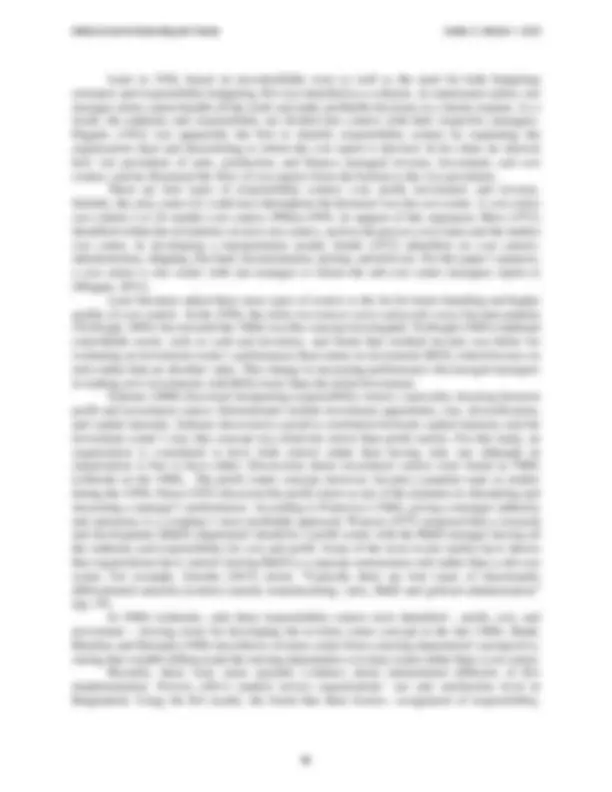
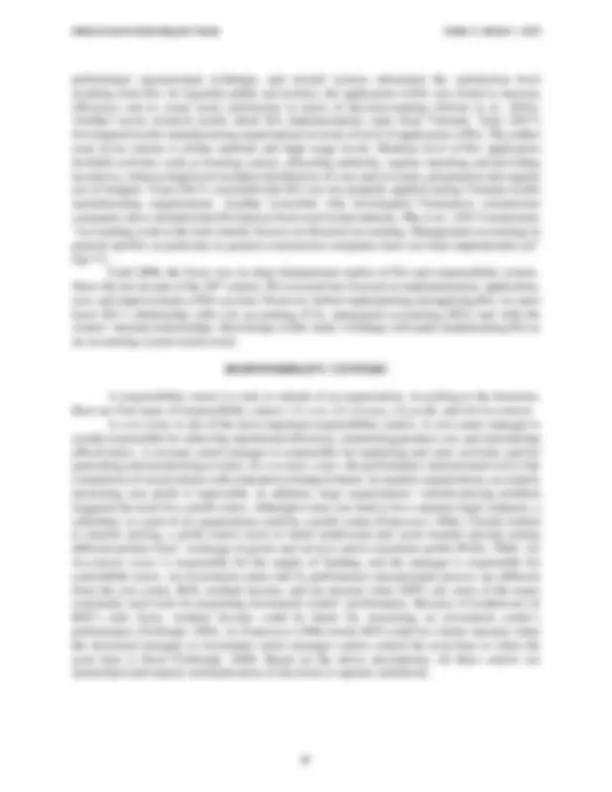
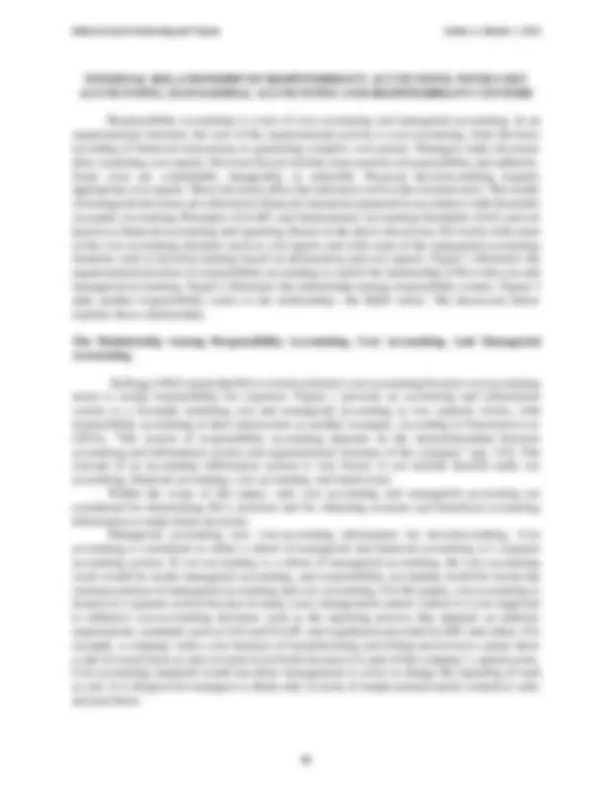
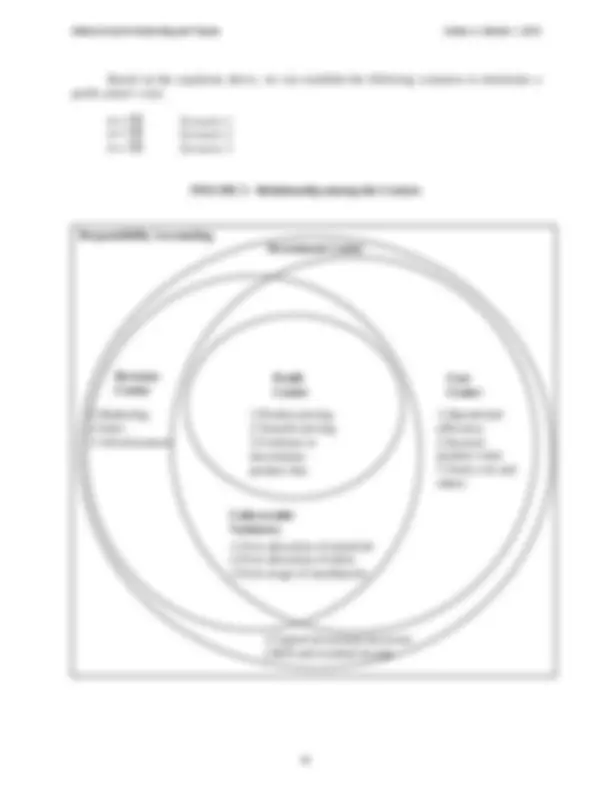
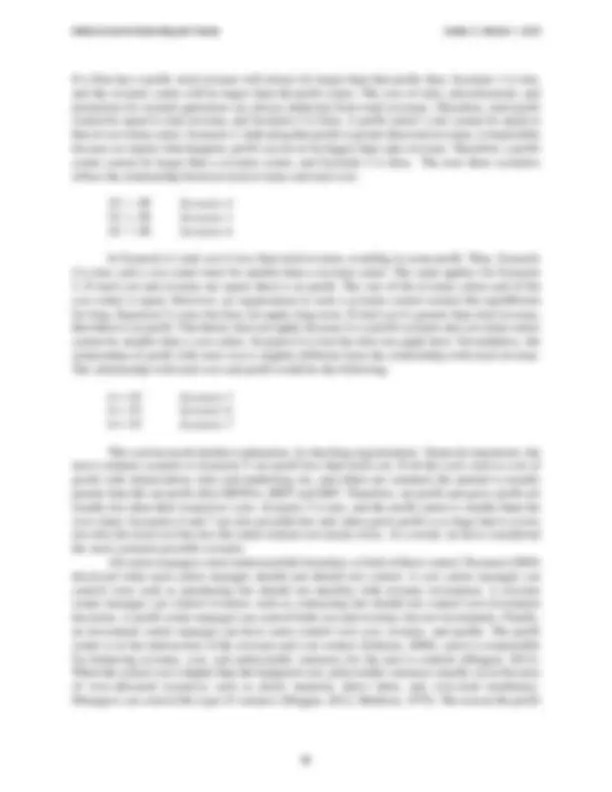
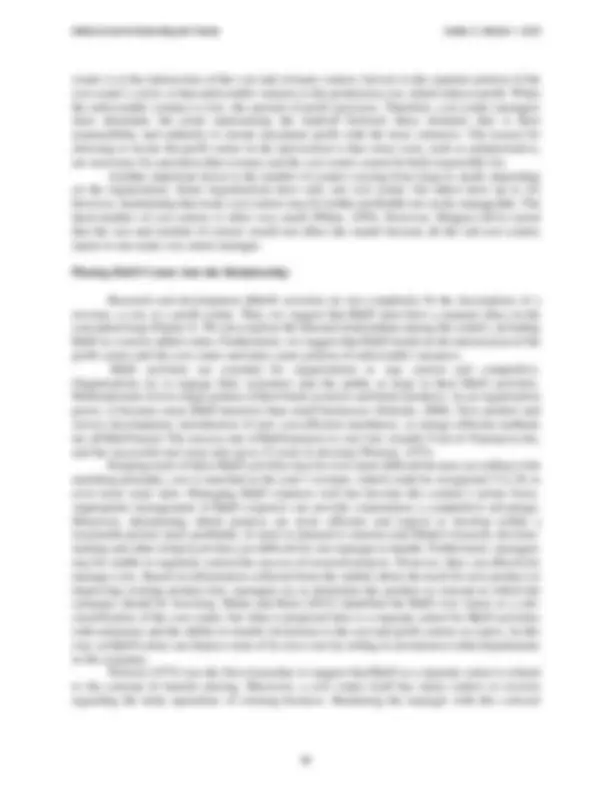
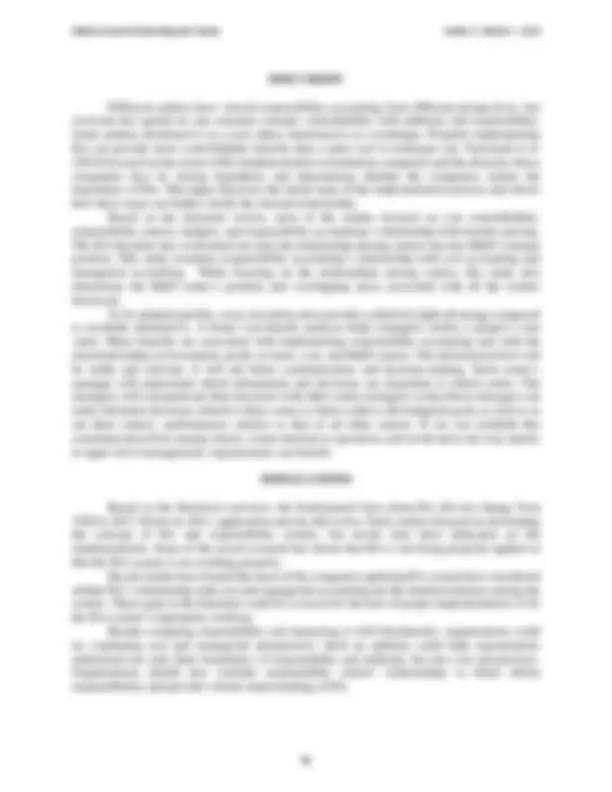
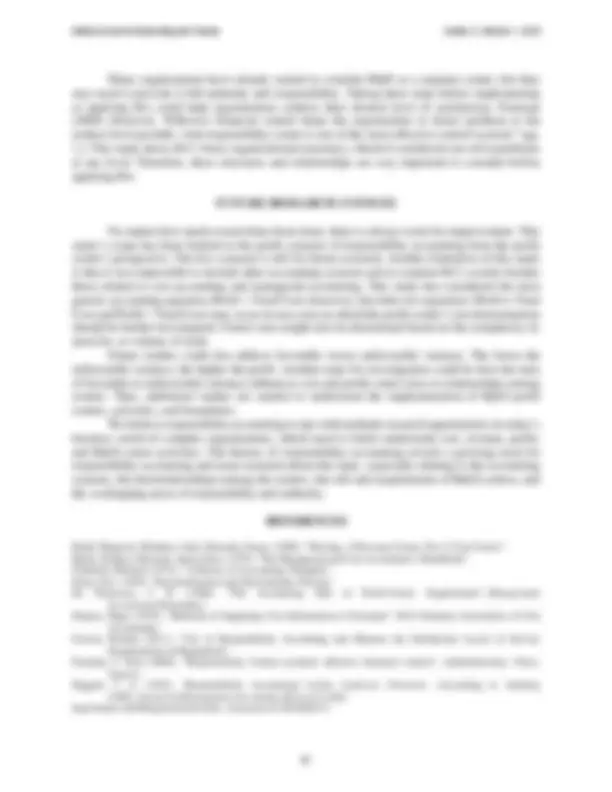
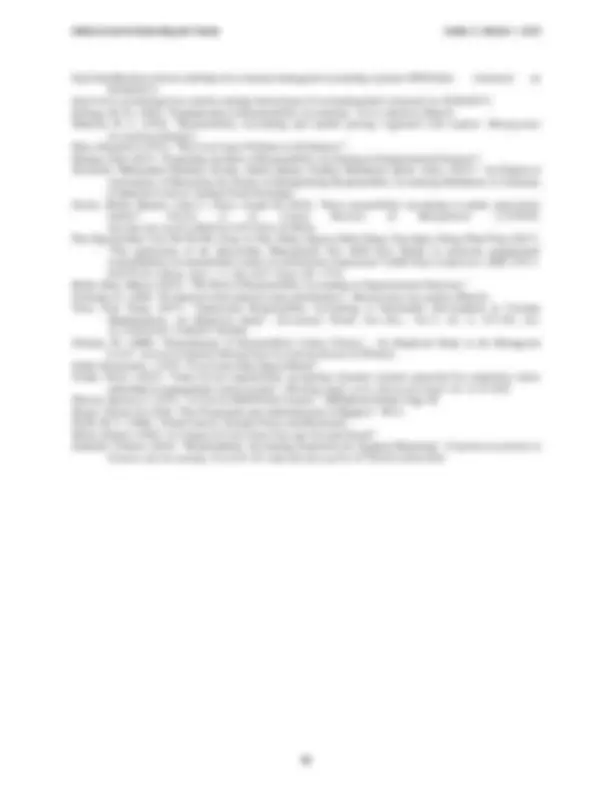


Study with the several resources on Docsity

Earn points by helping other students or get them with a premium plan


Prepare for your exams
Study with the several resources on Docsity

Earn points to download
Earn points by helping other students or get them with a premium plan
Community
Ask the community for help and clear up your study doubts
Discover the best universities in your country according to Docsity users
Free resources
Download our free guides on studying techniques, anxiety management strategies, and thesis advice from Docsity tutors
This paper provides an in-depth analysis of the historical development of responsibility accounting (RA) and responsibility centers, examining their relationships and positions in modern organizational accounting systems. the evolution of RA from the 1920s, including key studies and theorists, and discusses the various types of responsibility centers, such as cost, profit, investment, and revenue centers. It also explores the internal relationships of RA with cost accounting, managerial accounting, and the centers themselves.
What you will learn
Typology: Study notes
1 / 15

This page cannot be seen from the preview
Don't miss anything!










The importance of better analysis and decentralization of decision-making is increasing in today’s fast-paced, complex, and large-scale business operations. Responsibility accounting was introduced to accommodate the need for decentralization, accurate information, and analysis. In this paper, we review the evolution of the concept of responsibility accounting (RA) and responsibility centers since the 1920s. Based on the concept of responsibility accounting, managers responsible for their centers’ costs should have authority over those centers’ activities and expenditures. This study of RA’s historical development reveals interrelationships of cost, profit, revenue, and investment centers. Organizations’ daily activities—such as manufacturing, sales, and supply chain coordination—require capital investments, resulting in the investment centers’ covering all other centers. Traditionally, operations or manufacturing has been considered a cost center, while marketing and sales have been considered a revenue center. The intersection of cost and revenue centers is the profit center, which needs information from both the cost and the revenue centers and is related to transfer pricing. In this paper, we suggest a new center, namely research and development (R&D), to accommodate the ever-changing needs of development activities. Understanding the relationship among responsibility centers provides an organized information flow, which can enhance decision-making and cost control. This study focuses on the historical background and the position of responsibility accounting in an organizational accounting system. Future research avenues are also discussed.
INTRODUCTION
Decentralization can be traced back to 256 B.C. and the ancient Egyptians (Chatfield, 1974). The concept of delegating authority has always been effective for both business and non- profit purposes. When organizations grow, they not only expand in terms of size, profit and structure, but also face an increased number of tasks. As organizations and corporations progress, their managers’ work increases, and it gradually becomes more difficult to keep track of all the organization’s information and to make appropriate decisions based on that timely information (Mojgan, 2012). With decentralization, it is impossible for one person to carry out all the necessary, numerous, and various tasks and to make the best decisions for the organization (Madison, 1979). Accountants, industrial engineers, and others prudently developed a concept of decentralizing authority with a certain level of controllability and made all people responsible for their level of authority by having them report to top-level management or the authority above them according to the chain of command.
The responsibility accounting (RA) concept was introduced during the 1920s to handle varying levels of control and authority in management (Diemer, 1924 and Weger, 1926). According to Sawabe (2015), “Examining the practice of responsibility accounting system and its relationships with core values allow us to understand better the interactions and learning at the bottom layers of an organization” (pg.10). RA is designed to control expenditures by the individuals who are actually responsible for these expenditures (Higgins, 1952). It refers to the authority given to managers in charge of cost control, holding them responsible for the costs related to their operations. Holding one manager responsible for all the controllable cost is burdensome; thus, responsibility centers are needed. An entire organization can be viewed from four responsibility centers: cost, revenue, profit, and investment. Large businesses usually have numerous departments and centers; thus, daily operations are complex, and job boundaries are difficult to identify. In contrast, the work is easily manageable in small-scale organizations. Thus, responsibility accounting may not be as helpful in small organizations as it is in large ones (Ritika and Rani, 2015). Establishing responsibility centers is necessary to implement RA. For each responsibility center, a manager is assigned to handle that center with a limited level of authority for decision-making related to the center’s activities. Every dollar should be under the control of at least one manager (Neal, 2004). Improvement in responsibility accounting may help large organizations create a more organized internal structure. The purpose of this paper is to trace the historical development of responsibility accounting (RA) concept and implementation of RA centers, help understand the relationships among centers, and determine responsibility accounting’s position in a modern organizational accounting system. Successfully identifying RA’s position results in better implementation. Proper positioning also increases understanding of where to begin the implementation process. Based on recent studies, the application of RA and the satisfaction level it produces in different sectors and countries indicate better management and control. The relationships among centers provide appropriate information flow, thus accelerating the reporting process as well as organizational activities.
HISTORICAL BACKGROUND OF RESPONSIBILITY ACCOUNTING
This study has tried to trace RA’s origin and evolution. During the 1950s and 1960s, companies’ economic activities were significantly diversified (Zimnicki, 2016). Gradually, the need for decentralization and responsibility accounting increased. Although RA was initiated in the 1920s, it gained much popularity during the 1950s. The history of responsibility accounting is closely related to the development of cost-reporting activities. Cost accounting’s effectiveness depends on the flow of reporting and the quality of cost information among an organization’s multiple departments. During the 1920s, the cost communications among accountants, engineers, production foremen, sales executives, and others started to question both cost information’s quality and who would receive that information. They began to question the policies, procedures, cost classifications, forms of report, and persons to whom to report. In an industry cost-report study, Diemer (1924) found that only a small number of cost reports were brought to the foreman’s attention, while the rest of the reports were directed to managers because they did not want the foreman to have profit information. Higgen Botham (1924), as mentioned in Black and Edwards (1979), emphasized the importance of holding a manager responsible for costs. He also discussed giving the manager authority in terms of cost controllability before putting the manager in charge of the center.
performance measurement technique, and reward system—determine the satisfaction level resulting from RA. In Ugandan public universities, the application of RA was found to increase efficiency and to create more satisfaction in terms of decision-making (Owino et al., 2016). Another recent research results about RA implementation came from Vietnam. Tuan (2017) investigated textile-manufacturing organizations in terms of level of application of RA. The author used seven criteria to define medium and high usage levels. Medium level of RA application included activities such as forming centers, allocating authority, regular reporting and providing incentives, whereas high level included distribution of costs and revenues, preparation and regular use of budgets. Tuan (2017) concluded that RA was not properly applied among Vietnam textile manufacturing organizations. Another researcher who investigated Vietnamese construction companies also concluded that RA had not been used in that industry. Phu et al., (2017) mentioned, “Accounting work at the units mainly focuses on financial accounting. Management accounting in general and RA in particular in general construction companies have not been implemented yet” (pg.11). Until 2000, the focus was on deep fundamental studies of RA and responsibility centers. Since the last decade of the 20 th^ century, RA research has focused on implementation, application, uses, and improvements of RA systems. However, before implementing and applying RA, we must know RA’s relationship with cost accounting (CA), managerial accounting (MA) and with the centers’ internal relationships. Knowledge of this study’s findings will make implementing RA as an accounting system much easier.
RESPONSIBILITY CENTERS
A responsibility center is a unit or subunit of an organization. According to the literature, there are four types of responsibility centers: (1) cost , (2) revenue , (3) profit , and (4) investment. A cost center is one of the most important responsibility centers. A cost center manager is usually responsible for achieving operational efficiency, minimizing product cost, and maximizing effectiveness. A revenue center manager is responsible for marketing and sales activities and for generating and maximizing revenue. In a revenue center , the performance measurement tool is the comparison of actual returns with estimated or budged returns. In modern organizations, accurately measuring core profit is impossible. In addition, large organizations’ transfer-pricing problem triggered the need for a profit center. Although it does not need to be a separate legal company, a subsidiary or a part of an organization could be a profit center (Francesco, 1966). Closely related to transfer pricing, a profit center exists to better understand and assist transfer pricing among different product lines’ exchange of goods and services and to maximize profit (Wells, 1968). An investment center is responsible for the supply of funding, and the manager is responsible for controllable assets. An investment center and its performance measurement process are different from the cost center. ROI, residual income, and net present value (NPV) are some of the many commonly used tools for measuring investment centers’ performance. Because of weaknesses in ROI’s ratio focus, residual income could be better for measuring an investment center’s performance (Terborgh, 1969). As Francesco (1966) noted, ROI could be a better measure when the divisional manager or investment center manager cannot control the asset base or when the asset base is fixed (Terborgh, 1969). Based on the above descriptions, all these centers are interrelated and require communication of decisions to operate seamlessly.
Responsibility accounting is a mix of cost accounting and managerial accounting. In an organizational structure, the core of the organizational activity is cost accounting, from the basic recording of financial transactions to generating complex cost reports. Managers make decisions after examining cost reports. Decision factors include some portion of responsibility and authority. Some costs are controllable, changeable, or reducible. Practical decision-making requires appropriate cost reports. These decisions affect the internal as well as the external users. The results of managerial decisions are reflected in financial statements prepared in accordance with Generally Accepted Accounting Principles (GAAP) and International Accounting Standards (IAS) and are known as financial accounting and reporting. Based on the above discussion, RA works with some of the cost accounting elements such as cost reports and with some of the managerial accounting elements such as decision-making based on information and cost reports. Figure 1 illustrates the organizational position of responsibility accounting to clarify the relationship of RA with cost and managerial accounting. Figure 2 illustrates the relationship among responsibility centers. Figure 3 adds another responsibility center to the relationship—the R&D center. The discussion below explains these relationships.
The Relationship Among Responsibility Accounting, Cost Accounting, And Managerial Accounting
Kellogg (1962) stated that RA is closely related to cost accounting because cost accounting needs to assign responsibility for expenses. Figure 1 presents an accounting and information system as a rectangle including cost and managerial accounting as two separate circles, with responsibility accounting in their intersection as another rectangle. According to Nawaiseh et al. (2014), “The system of responsibility accounting depends on the interrelationship between accounting and information system and organizational structure of the company” (pg. 125). The concept of an accounting information system is very broad. It can include internal audit, tax accounting, financial accounting, cost accounting, and much more. Within the scope of this paper, only cost accounting and managerial accounting are considered for determining RA’s position and for obtaining accurate and beneficial accounting information to make better decisions. Managerial accounting uses cost-accounting information for decision-making. Cost accounting is considered as either a subset of managerial and financial accounting or a separate accounting system. If cost accounting is a subset of managerial accounting, the cost accounting circle would be inside managerial accounting, and responsibility accounting would be inside the common portion of managerial accounting and cost accounting. For this paper, cost accounting is treated as a separate system because in many cases management cannot control or is not supposed to influence cost-accounting decisions such as the reporting process that depends on industry requirements; standards such as IAS and GAAP; and regulations provided by SEC and others. For example, a company with a core business of manufacturing and selling microwaves cannot show a sale of a used truck as sales revenue in its books because it is part of the company’s capital assets. Cost accounting standards would not allow management to cover or change the reporting of such as sale. It is illogical for managers to think only in terms of simple journal entries related to sales and purchases.
by the rectangle in the overlapping area of cost and managerial accounting. The outside area of the square is the non-controllable cost (i.e., managerial decisions cannot affect them). By properly positioning responsibility accounting, managers can better determine what they need to address for better performance outcomes in terms of organizational and personal purposes.
Relationship Among the Centers
Once controllable costs are identified, organizations must focus on sections producing and reducing those costs. By controlling these sections, managers can increase their organizations’ efficiency and effectiveness. If responsibility accounting is considered, many costs are controllable. Figure 2 illustrates the relationship among these centers, which are the responsibility of multiple managers. The investment center manager determines which project should be approached; the capital amount; budgeting techniques; and measurement of results with ROI, IRR, and many other methods (Terborgh, 1969). Noteworthy here is that investment centers fund all the costs and expenses (Madison, 1979 and Most, 1972). According to Freeman (2004), investment center managers may have some control over cost and revenue centers. Mojgan (2012) noted that investment center managers have some responsibility for profit, revenue, and cost centers. The investment center controls assets such as cash, inventories, and others (Terborgh, 1969). Investment of idle cash, use of inventories, and even some accounts receivable decisions are handled by the divisional manager or the investment center manager. The investment center is also responsible for funding and generating some portion of cost as well as revenue. Mojgan (2012) noted that profit is a measure to calculate the investment center’s performance. The above discussions place the investment center in the outer circle; inside this circle, the other circles evolve. Usually, the revenue center manager oversees marketing, advertising, sales, and promotion. Cost center managers are mainly responsible for controlling production costs so that production efficiency and superior quality are ensured. Profit center managers need information from both the cost and the revenue centers to understand their area of controllability, to determine the product contribution, and ultimately to identify ways to increase different product lines’ profits (Freeman, 2004). These managers are also responsible for generating statements to guide revenue and cost centers’ activities. An organization could have several profit centers (Francesco, 1966), depending on the product lines and the number of different products produced. Depending on the area of responsibility and profit structure, the profit center could be even bigger than the cost center. The equations below provide a basic idea about the size of the centers; however, size should not be limited to these equations:
π = TR – TC (Equation 1) π = (P * Q) – (UC * Q) (Equation 2) π = Q (P - UC) (Equation 3)
These equations represent a profit perspective where, π = Profit, TR = Total Revenue, TC = Total Cost, Q = Quantity, P = Price, UC = Unit cost.
Based on the equations above, we can establish the following scenarios to determine a profit center’s size:
π < TR Scenario 1 π = TR Scenario 2 π > TR Scenario 3
FIGURE 2 - Relationship among the Centers
Responsibility Accounting Investment Center
Revenue Center
Profit Center
Cost Center
1.Marketing 2.Sales 3.Advertisement
1.Over-allocation of materials 2.Over-allocation of labor 3.Over-usage of machineries
1.Operational efficiency 2.Increase product value 3.Track cost and others
1.Capital investment decisions 2.ROI and residual income
1.Product pricing 2.Transfer pricing 3.Continue or discontinue product line
Unfavorable Variances
center is at the intersection of the cost and revenue centers, but not in the separate portion of the cost center’s circle, is that unfavorable variance is the production cost, which reduces profit. When the unfavorable variance is low, the amount of profit increases. Therefore, cost center managers must determine the point representing the tradeoff between these elements that is their responsibility and authority to ensure maximum profit with the least variances. The reason for choosing to locate the profit center in the intersection is that some costs, such as administrative, are necessary for operation that revenue and the cost center cannot be held responsible for. Another important factor is the number of centers varying from large to small, depending on the organization. Some organizations have only one cost center, but others have up to 24; however, maintaining that many cost centers may be neither profitable nor easily manageable. The ideal number of cost centers is often very small (White, 1959). However, Mojgan (2012) noted that the size and number of centers would not affect the model because all the sub-cost centers report to one main cost center manager.
Placing R&D Center into the Relationship
Research and development (R&D) activities do not completely fit the descriptions of a revenue, a cost, or a profit center. Thus, we suggest that R&D must have a separate place in the conceptual map (Figure 3). We also explore the internal relationships among the centers, including R&D as a newly added center. Furthermore, we suggest that R&D stands in the intersection of the profit center and the cost center and takes some portion of unfavorable variances. R&D activities are essential for organizations to stay current and competitive. Organizations try to engage their customers and the public at large in their R&D activities. Multinationals invest a huge portion of their funds in newer and better products. As an organization grows, it becomes more R&D intensive than small businesses (Schoute, 2008). New product and service development, introduction of new cost-efficient machinery, or energy-efficient methods are all R&D based. The success rate of R&D projects is very low; usually 9 out of 10 projects die, and the successful ones may take up to 15 years to develop (Watson, 1975). Keeping track of these R&D activities may be even more difficult because according to the matching principle, cost is matched in the year’s revenue, which could be recognized 5 to 20 or even more years later. Managing R&D expenses well has become this century’s prime focus. Appropriate management of R&D expenses can provide corporations a competitive advantage. Moreover, determining which projects are more efficient and logical to develop within a reasonable period, more profitable, or more in demand is onerous task Market research, decision- making and other related activities are difficult for one manager to handle. Furthermore, managers may be unable to regularly control the success of research projects. However, they can effectively manage costs. Based on information collected from the market about the need for new product or improving existing product line, managers try to determine the product or concept in which the company should be investing. Ritika and Rani (2015) identified the R&D cost center as a sub- classification of the cost center; but what is proposed here is a separate center for R&D activities with autonomy and the ability to transfer inventions to the cost and profit centers at a price. In this way, an R&D center can finance some of its own costs by selling its invention to other departments in the company. Watson (1975) was the first researcher to suggest that R&D as a separate center is related to the concept of transfer pricing. Moreover, a cost center itself has many centers to oversee regarding the daily operations of existing business. Burdening the manager with this colossal
responsibility of R&D with its uncertain outcomes works in opposition to the objectives of the development activities and growth. A cost center manager may focus only on costs, not on the research activities’ revenue or profit improvements. However, an R&D center will be looking for both the cost and profit related to R&D (Watson, 1975) that will make it easy to track the long- term R&D projects, R&D costs, and profits. Watson (1975) was the first researcher to suggest that R&D as a separate center is related to the concept of transfer pricing. Moreover, a cost center itself has many centers to oversee regarding the daily operations of existing business. Burdening the manager with this colossal responsibility of R&D with its uncertain outcomes works in opposition to the objectives of the development activities and growth. A cost center manager may focus only on costs, not on the research activities’ revenue or profit improvements. However, an R&D center will be looking for both the cost and profit related to R&D (Watson, 1975) that will make it easy to track the long- term R&D projects, R&D costs, and profits. Any R&D center’s invention generated and transferred to a cost center may help it to reduce cost. After developing new products, an R&D center transfers them to the profit center at a cost. Because the profit center makes product-line decisions, such as which products to continue, which to discontinue, and which to add, the profit center buys the invention from the R&D center so that the cost center can produce the product and the revenue center can sell it at a profit. A new R&D center must have a separate manager to identify development opportunities new inventions, and cost-effective measures as well as to determine profits. One might wonder why an R&D center and a cost center overlap. As previously noted, investment centers sponsor everything; in contrast, most of an R&D center’s work is related to developing new products, focusing on cost- reduction projects, or designing energy-efficient machinery. Another question is why the entire R&D center does not fall into the cost center. Many other activities in an organization do not relate to the cost center such as doing market research or searching for technological availability. Figure 3 reveals that under the same RA concept, the new R&D center is proposed to have a better command over R&D cost and profits and to encourage R&D activities. A separate manager will be given the authority and responsibility for the R&D costs, keep track of the years needed for developing, record revenues, and look for new R&D opportunities. An R&D center generates cost through research and development, so it is in some portion of the cost center. An R&D center also works with profit and sells its invention, so it takes a portion of profit of the revenue center. Furthermore, an R&D center also has the burden of dealing with dead projects and of absorbing some of the unrecoverable costs, a portion of unfavorable variances. A profit center manager is not responsible for the cost of experimenting because it is not under his control. The cost center manager cannot be held responsible for the R&D center’s fluctuating profit or even R&D’s huge cost, which he cannot control. Thus, a separate R&D center manager who has authority and responsibility that is controllable is necessary
Different authors have viewed responsibility accounting from different perspectives, but everyone has agreed on one common concept: controllability with authority and responsibility. Some authors mentioned it as a tool; others mentioned it as a technique. Properly implementing RA can provide more controllability benefits than a mere tool or technique can. Nawaiseh et al. (2014) focused on the extent of RA implementation in Jordanian companies and the obstacles those companies face by testing hypothesis and determining whether the companies realize the importance of RA. This paper discusses the initial steps of the implementation process and shows how these steps can further clarify the internal relationship. Based on the literature review, most of the studies focused on cost controllability, responsibility centers, budgets, and responsibility accounting’s relationship with transfer pricing. The RA literature has overlooked not only the relationship among centers but also R&D’s unique position. This study examines responsibility accounting’s relationship with cost accounting and managerial accounting. While focusing on the relationships among centers, this study also determines the R&D center’s position and overlapping areas associated with all the centers discussed. To be adopted quickly, every invention must provide a relatively high advantage compared to available alternatives. A better cost-benefit analysis helps managers realize a project’s true value. Many benefits are associated with implementing responsibility accounting and with the interrelationship of investment, profit, revenue, cost, and R&D centers. The information flow will be stable and relevant. It will aid better communication and decision-making. Each center’s manager will understand which information and decisions are important to which center. The managers will communicate their decisions with other center managers so that those managers can make informed decisions related to their center to better achieve the budgeted goals as well as to see their centers’ performances relative to that of all other centers. If we can establish this communication flow among centers, create internal co-operation, and avoid mere one-way reports to upper-level management, organizations can benefit.
IMPLICATIONS
Based on the historical overview, the fundamental facts about RA did not change from 1920 to 2017. However, RA’s application and use did evolve. Early studies focused on developing the concept of RA and responsibility centers; but recent ones have dedicated on the implementation. Some of the recent research has shown that RA is not being properly applied or that the RA system is not working properly. Recent studies have found that most of the companies applying RA system have considered neither RA’s relationship with cost and managerial accounting nor the internal relations among the centers. These gaps in the literature could be a reason for the lack of proper implementation or for the RA system’s improperly working. Besides assigning responsibility and measuring it with benchmarks, organizations could try explaining cost and managerial perspectives. Such an addition could help organizations understand not only their boundaries of responsibility and authority but also cost perspectives. Organizations should also consider responsibility centers’ relationships to better define responsibilities and provide a better understanding of RA.
Many organizations have already started to consider R&D as a separate center, but they may need to provide it full authority and responsibility. Taking these steps before implementing or applying RA could help organizations achieve their desired level of satisfaction. Freeman (2004) observed, “Effective financial control helps the organization to detect problem at the earliest level possible. And responsibility center is one of the most effective control systems” (pg. 1,). This study shows RA’s basic organizational structures, which if considered can solve problems at any level. Therefore, these structures and relationships are very important to consider before applying RA.
FUTURE RESEARCH AVENUES
No matter how much research has been done, there is always room for improvement. This study’s scope has been limited to the profit scenario of responsibility accounting from the profit center’s perspective. The loss scenario is left for future research. Another limitation of this study is that it was impossible to include other accounting systems and to examine RA’s results besides those related to cost accounting and managerial accounting. This study has considered the most generic accounting equation (Profit < Total Cost); however, the other two equations (Profit = Total Cost and Profit > Total Cost) may occur in rare cases in which the profit center’s size determination should be further investigated. Center sizes might also be determined based on the complexity of, need for, or volume of work. Future studies could also address favorable versus unfavorable variance. The lower the unfavorable variance, the higher the profit. Another topic for investigation could be how the ratio of favorable to unfavorable variance influences cost and profit center sizes or relationships among centers. Thus, additional studies are needed to understand the implementation of R&D profit centers, activities, and boundaries. We believe responsibility accounting is ripe with multiple research opportunities in today’s business world of complex organizations, which need to better understand cost, revenue, profit, and R&D center activities. The history of responsibility accounting reveals a growing need for responsibility accounting and more research about this topic, especially relating to the accounting systems, the interrelationships among the centers, the role and requirements of R&D centers, and the overlapping areas of responsibility and authority.
REFERENCES
Budd, Margorie; Blaufuss, Judy; Haranda, Susan. (1988). “Nursing: A Revenue Center, Not A Cost Center”. Black, Holmer; Edwards, James Don, (1979). “The Managerial and Cost Accountant’s Handbook”. Chatfield, Michael (1974). “A History of Accounting Thoughts”. Dean, Joel. (1955). “Decentralization and Intracompany Pricing”. De Francesco, J. D. (1966). “The Accounting Side of Profit-Center Organization”. Management Accounting (December). Diemer, Hugo (1924). “Methods of Supplying Cost Information to Foreman”. NCA-National Association of Cost Accountants. Fowzia, Rehana (2011). “Use of Responsibility Accounting and Measure the Satisfaction Levels of Service Organizations in Bangladesh”. Freeman, L Neal (2004). “Responsibility Centers promote effective financial control”. ( Ophthalmology Times, August ). Higgins, J. A. (1952). “Responsibility Accounting”. Arthur Andersen Chronicle. (According to Anthony [1989. Journal of Management Accounting Research (10)]) http://maaw.info/ResponArticles.htm (Assessed on 05/20/2017)